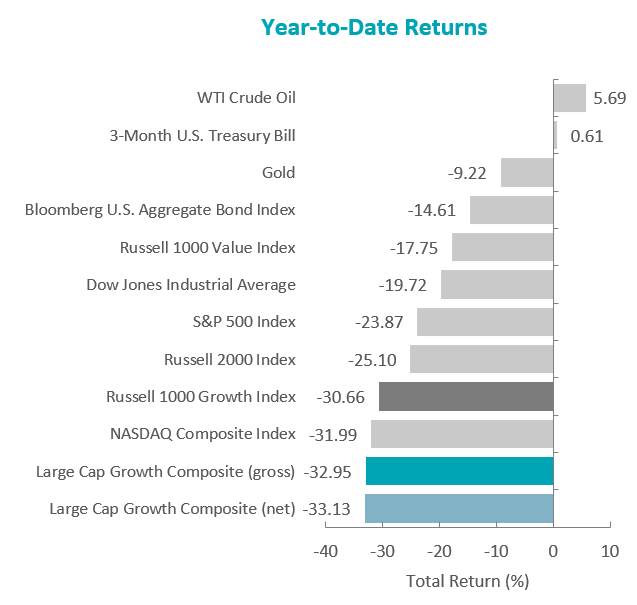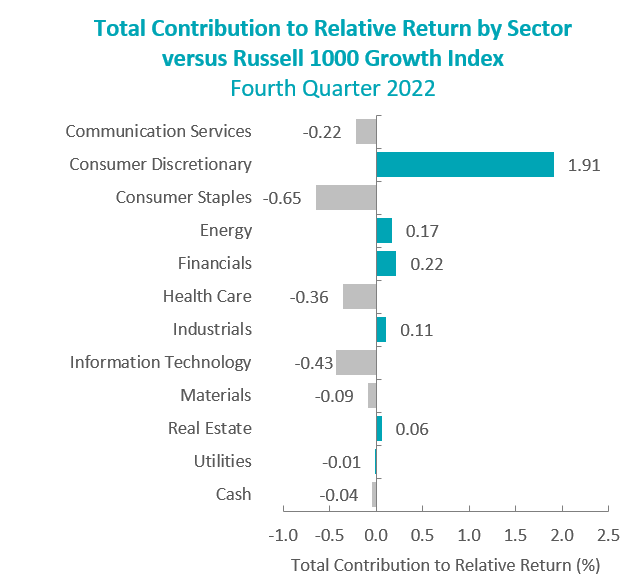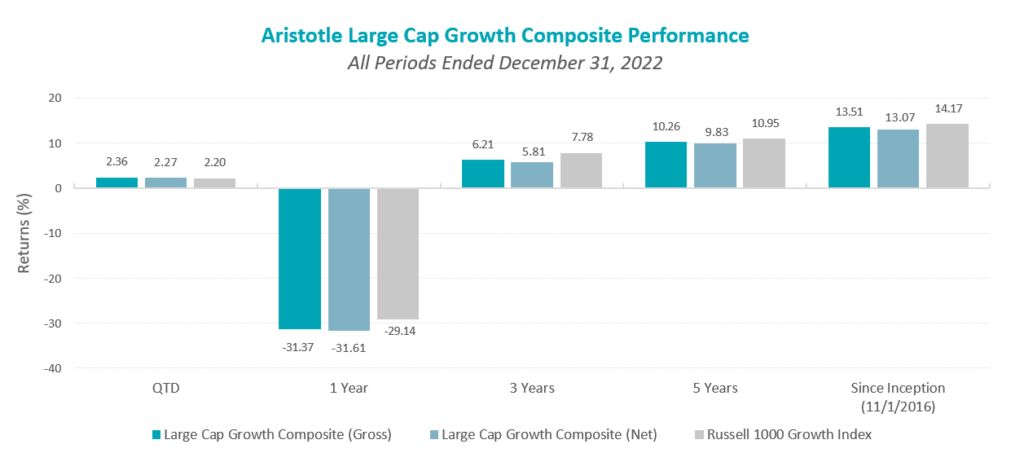Commentary
Large Cap Growth 4Q 2022
Markets Review
U.S. equity market performance was positive in the final quarter of the year, as the S&P 500 Index rose 7.56% during the period. Concurrently, the Bloomberg U.S. Aggregate Bond Index increased 1.87% for the quarter. In terms of style, the Russell 1000 Value Index outperformed its growth counterpart by 10.22% during the quarter.

Sources: SS&C Advent, Bloomberg
Past performance is not indicative of future results. Aristotle Atlantic Large Cap Growth Composite returns are presented gross and net of investment advisory fees and include the reinvestment of all income. Gross returns will be reduced by fees and other expenses that may be incurred in the management of the account. Net returns are presented net of actual investment advisory fees and after the deduction of all trading expenses. Aristotle Atlantic Composite returns are preliminary pending final account reconciliation. Please see important disclosures at the end of this document.
On a sector basis, nine out of eleven sectors within the Russell 1000 Growth Index finished higher for the quarter, with Utilities, Industrials and Health Care gaining the most. Meanwhile, Consumer Discretionary and Communication Services posted the largest declines and Information Technology rose the least.
Inflation has remained elevated in the U.S., with a 7.1% rise in the CPI for the 12-month period ending in November. However, increases have slowed since the second half of the year, as the annualized CPI figure has come down steadily since reaching a 40-year high of 9.1% in June. This moderation in price increases was partly driven by falling energy costs, as average U.S. gasoline prices approached $3 a gallon—lows not seen since before Russia invaded Ukraine. When assessing consumer health, spending proved resilient and the labor market remained tight, with a 3.7% unemployment rate and a 5.1% year-over-year increase in average hourly earnings in November. With respect to the U.S. economy’s overall performance, investors welcomed news that GDP grew at an annual rate of 3.2% in the third quarter following two consecutive quarters of contraction.
As inflation trended lower, the Federal Reserve (Fed) slowed the pace of rate increases to 0.5% in December after raising rates by 0.75% for the fourth consecutive time in November, moving the benchmark rate to a range of 4.25% to 4.50%. Although the magnitude of rate hikes has shifted down, the Fed has indicated that, given the current labor market and its 2% inflation target, there is still more work to be done from a monetary policy standpoint. As such, apprehension around a recession remains; however, the Fed’s decision to step down from 0.75% increases and the weakening dollar alleviated some of those concerns heading into the new year.
On the corporate earnings front, signals remained mixed, as 70% of S&P 500 companies exceeded EPS estimates, while 61% of S&P 500 companies provided negative EPS guidance for the third quarter. In addition, management teams have continued to navigate the inflationary environment, with roughly 400 companies mentioning inflation on earnings calls.
Lastly, in U.S. politics, the Republican Party won a majority in the House of Representatives, while the Democratic Party retained control of the Senate after the 2022 midterm elections. The results end one-party control of Congress for the remainder of the Biden administration’s first term.
Annual Markets Review
After posting seven consecutive quarters of positive performance prior to 2022, the U.S. equity market faltered, as the S&P 500 Index finished lower for the first three quarters of the year, leading to a full-year return of -18.11%. Additionally, after five straight calendar years of growth outperforming value, the Russell 1000 Value Index outperformed the Russell 1000 Growth Index by 21.60%, the largest outperformance by value since 2000.
Meanwhile, despite fixed income’s tendency to provide stability when equities are turbulent, the Bloomberg U.S. Aggregate Bond Index fell 13.01%—its worst year on record. 2022 easily surpassed the Index’s previous worst year, when it declined 2.92% in 1994 as inflation and the corresponding interest rate environment remained primary themes. Macroeconomic headlines were dominated by inflation, while factors such as geopolitical conflict, supply-chain disruptions, labor shortages and increasing commodity and housing prices also played a role.
Although it was a challenging year, these volatile periods are precisely why we emphasize the phrase, “not every quarter, not every year.” Short-term returns are always subject to change, and macroeconomic factors such as inflation, central bank policies and geopolitical conflicts are impossible to predict. Consequently, we remain focused on the long-term fundamentals of businesses, and we strive to identify undervalued, high-quality companies that can weather the complex and changing market dynamics. We believe this steadfast approach will allow us to provide lasting long-term value to our clients.
Performance and Attribution Summary
For the fourth quarter of 2022, Aristotle Atlantic’s Large Cap Growth Composite posted a total return of 2.27% net of fees (2.36% gross of fees), outperforming the 2.20% total return of the Russell 1000 Growth Index.
| Performance (%) | 4Q22 | 1 Year | 3 Years | 5 Years | Since Inception* |
|---|---|---|---|---|---|
| Large Cap Growth Composite (gross) | 2.36 | -31.37 | 6.21 | 10.26 | 13.51 |
| Large Cap Growth Composite (net) | 2.27 | -31.61 | 5.81 | 9.83 | 13.07 |
| Russell 1000 Growth Index | 2.20 | -29.14 | 7.78 | 10.95 | 14.17 |
*The Large Cap Growth Composite has an inception date of November 1, 2016. Past performance is not indicative of future results. Aristotle Atlantic Large Cap Growth Equity Composite returns are presented gross and net of investment advisory fees and include the reinvestment of all income. Gross returns will be reduced by fees and other expenses that may be incurred in the management of the account. Net returns are presented net of actual investment advisory fees and after the deduction of all trading expenses. Aristotle Atlantic Composite returns are preliminary pending final account reconciliation. Please see important disclosures at the end of this document.

Sources: FactSet
Past performance is not indicative of future results. Attribution results are based on sector returns which are gross of investment advisory fees. Attribution is based on performance that is gross of investment advisory fees and includes the reinvestment of income. Please see important disclosures at the end of this document.
During the fourth quarter, the portfolio’s outperformance relative to the Russell 1000 Growth Index was due to security selection while allocation effects moderately detracted. Security selection in Consumer Discretionary, Industrials and Financials contributed the most to relative performance. Conversely, security selection in Health Care, Consumer Staples and Information Technology detracted the most from relative returns.
Contributors and Detractors for 4Q 2022
| Relative Contributors | Relative Detractors |
|---|---|
| Horizon Therapeutics | Guardant Health |
| Dexcom | CrowdStrike Holdings |
| O’Reilly Automotive | Iovance Biotherapeutics |
| Visa | Amazon |
| AMETEK | Twilio |
Contributors
Horizon Therapeutics
Horizon Therapeutics was a relative contributor, as its stock price was up on news that Amgen was acquiring the company for $116.50 per share, a roughly 36% premium to the pre-deal speculation price.
Dexcom
Dexcom shares were strong following a solid third quarter earnings announcement, as well as news of additional Medicare reimbursement and that the FDA has approved their next generation device, G7, in early December.
Detractors
Guardant Health
Guardant shares were weak following the release of the pivotal Eclipse trial in over 20,000 patients to evaluate performance of its blood-based test, Shield, for detecting colorectal cancer (CRC) in average-risk adults. Sensitivity was 83%, marginally below investor expectations of 85%. Detection of advanced adenomas (AA) came in at 13% which was lower than the 20% update that took the stock down previously. We believe, as does the company, that the results are sufficient to gain FDA approval for the minimally invasive blood screening test and to capture a meaningful share of the 49 million average-risk adults who are recommended for screening and yet are still not screened.
CrowdStrike Holdings
CrowdStrike detracted from performance in the quarter due to lower-than-expected net new annual recurring revenue (ARR) as reported on the company’s third quarter earnings call. The overall cybersecurity software space saw a pullback in the quarter, as investors are concerned about a slowdown in spending. Additionally, management reduced the company’s fourth quarter net new ARR guide, further raising concerns of a greater-than-anticipated slowdown. We believe that management is being very conservative in their guide to reset expectations in the face of significant macroeconomic uncertainties and see underlying metrics and win rates as being supportive of the long-term growth rate of the company which we consider to be a franchise leader in the cybersecurity software space.
Recent Portfolio Activity
The table below shows all buys and sells completed during the quarter, followed by a brief rationale.
| Buys | Sells |
|---|---|
| Quanta Services | Twilio |
| KLA | Snowflake |
| Adobe |
Buys
Quanta Services
Quanta Services is a specialty infrastructure service provider for the utility, renewable energy, communications and energy industries. The company reports in three segments: Electric Power Infrastructure Solutions, Renewable Energy Infrastructure Solutions and Underground Utility & Infrastructure Solutions. Quanta is involved in the full scope of its projects from design, engineering, project management, installation, maintenance and replacement.
We believe premium multiples are warranted because the company has been exceeding consensus estimates over the past few years as well as the increased exposure to trends in renewable power. The Electric Power solutions is the largest segment at 50% of revenue. This segment is exposed to trends in electric grid modernization and hardening. We expect this segment will benefit from increasing demands for electricity for electric vehicles. The Renewable Energy Solutions segment and Underground Utility & Infrastructure Solutions are each approximately 25% of total revenue and look to benefit from renewable power growth and replacement business opportunities.
KLA
KLA is a supplier of process control equipment and data analytics products for a broad range of industries, including semiconductors, printed circuit boards (PCB) and displays. It provides solutions for manufacturing and testing wafers and reticles, integrated circuits (IC or chip), packaging, light-emitting diodes (LED), power devices, compound semiconductor devices, microelectromechanical systems (MEMS), data storage, PCBs, flat and flexible panel displays, and general materials research, as well as providing contracted and comprehensive installation and maintenance services across its installed base. Customers in international markets account for about 90% of the company’s revenue.
We see a unique opportunity in KLA to benefit from the increasing complexity of semiconductor wafer manufacturing through its leading position in process technology and wafer inspection. We believe Wafer Fab Equipment (WFE) spending will continue to rise over the next decade, as semiconductor capital intensity remains elevated and as semiconductors continue to account for a larger share of the global economy due to the above average growth of IoT devices, auto electrification, data center and cloud computing, and mobile communication/computing. We see the stock as an attractive investment opportunity, as investor expectations for 2023 have been reset at lower levels following WFE capital expenditures (CapEx) cuts by foundries and semiconductor companies.
Sells
Twilio
We sold Twilio and thereby reduced our subsector weight in software. The company reported a decent third quarter, but disappointed on fourth quarter 2022, full year 2023, and long-term guidance. The company is seeing macroeconomic headwinds and a slowdown spreading from technology, social media and cryptocurrency to retail and e-commerce. The other negative disclosure and a driver of this gross margin “miss” is that Twilio’s software sales are not accelerating at the rate that we expected. We are disappointed with this lower topline guide and low operating margin improvement guide. The business transformation is taking longer than expected, and there is the heightened possibility that the new software growth could be stifled by more formidable competition as Twilio has made too many missteps.
Snowflake
We sold Snowflake and thereby reduced our subsector weight in software. We see risks to the consumption model from further spending cuts and rationalizations across their core verticals which include finance, technology and media. These three verticals have contributed to the weaknesses in the digital advertising space. We have increasing concerns that even the company’s conservative Fiscal Year 2023 guide for revenue growth could now be pressured, as customer spending cuts have accelerated.
Adobe
We sold our position in Adobe, as we see continued macroeconomic pressures affecting the business’s digital media business through reduced headcount at both enterprise and small businesses. We also see further slowing e-commerce and advertising trends leading to lower growth rates in the digital experience business unit impacting the margin expansion thesis. Adobe’s recent acquisition announcement of Figma highlights the concerns we see around increased competitive pressures which we see as negative for both growth and margins over the next few years. The regulatory concerns around the deal closing will also mean less clarity for ongoing business initiatives which we see as a further headwind for the stock in the near term.
Outlook
The focus for equity investors going into 2023 will be the potential for an economic recession and the corresponding impact on corporate profits. Although inflation may have peaked, the Federal Reserve will potentially look to continue to raise interest rates and reduce their balance sheet in an effort to cool the labor market. One of the key statistics tracking the labor market is the Job Openings and Labor Turnover Survey (JOLTS), which has started to show signs of softening, with the number of job openings declining from recent highs. The gap between job openings and people looking for work still stands at an elevated ratio of 1.7 as of October 2022. With the labor market still tight, the Federal Reserve will most likely raise interest rates another two to three times in 2023 with the potential for the federal funds rate to peak at 5.00% to 5.25%. Although the federal funds futures point to the potential for a pivot into an easing cycle, the most likely scenario is for the Federal Reserve to take a wait-and-see approach once they are done raising rates. This can create an uncertain economic environment for at least the first half of 2023. On a positive note, the price of goods may likely continue to decline as many of the issues around tight supply chain have eased. The pace of decline in goods prices could very well be delayed or lessened by the spike in COVID-19 cases in China. As we approach the second half of the year, the debt ceiling could add to equity market volatility, as we now have a split party government. Lastly, the uncertain outcome and potential for escalation in Ukraine on the part of Russia may, at times, unsettle markets. The equity market will most likely struggle at the start of 2023, as investors weigh the economic impact of an aggressive tightening cycle. Once the Federal Reserve signals the end of the tightening cycle, we should expect a sizable rally in equity markets. Our focus will continue to be at the company level, with an emphasis on seeking to invest in companies with secular tailwinds or strong product-driven cycles.
Disclosures
The opinions expressed herein are those of Aristotle Atlantic Partners, LLC (Aristotle Atlantic) and are subject to change without notice. Past performance is not a guarantee or indicator of future results. This material is not financial advice or an offer to purchase or sell any product. You should not assume that any of the securities transactions, sectors or holdings discussed in this report were or will be profitable, or that recommendations Aristotle Atlantic makes in the future will be profitable or equal the performance of the securities listed in this report. The portfolio characteristics shown relate to the Aristotle Atlantic Large Cap Growth strategy. Not every client’s account will have these characteristics. Aristotle Atlantic reserves the right to modify its current investment strategies and techniques based on changing market dynamics or client needs. There is no assurance that any securities discussed herein will remain in an account’s portfolio at the time you receive this report or that securities sold have not been repurchased. The securities discussed may not represent an account’s entire portfolio and, in the aggregate, may represent only a small percentage of an account’s portfolio holdings. The performance attribution presented is of a representative account from Aristotle Atlantic’s Large Cap Growth Composite. The representative account is a discretionary client account which was chosen to most closely reflect the investment style of the strategy. The criteria used for representative account selection is based on the account’s period of time under management and its similarity of holdings in relation to the strategy. Recommendations made in the last 12 months are available upon request. Returns are presented gross and net of investment advisory fees and include the reinvestment of all income. Gross returns will be reduced by fees and other expenses that may be incurred in the management of the account. Net returns are presented net of actual investment advisory fees and after the deduction of all trading expenses.
All investments carry a certain degree of risk, including the possible loss of principal. Investments are also subject to political, market, currency and regulatory risks or economic developments. International investments involve special risks that may in particular cause a loss in principal, including currency fluctuation, lower liquidity, different accounting methods and economic and political systems, and higher transaction costs. These risks typically are greater in emerging markets. Securities of small‐ and medium‐sized companies tend to have a shorter history of operations, be more volatile and less liquid. Value stocks can perform differently from the market as a whole and other types of stocks.
The material is provided for informational and/or educational purposes only and is not intended to be and should not be construed as investment, legal or tax advice and/or a legal opinion. Investors should consult their financial and tax adviser before making investments. The opinions referenced are as of the date of publication, may be modified due to changes in the market or economic conditions, and may not necessarily come to pass. Information and data presented has been developed internally and/or obtained from sources believed to be reliable. Aristotle Atlantic does not guarantee the accuracy, adequacy or completeness of such information.
The Russell 1000® Growth Index measures the performance of the large cap growth segment of the U.S. equity universe. It includes those Russell 1000 companies with higher price-to-book ratios and higher forecasted growth values. This index has been selected as the benchmark and is used for comparison purposes only. The Russell 1000® Value Index measures the performance of the large cap value segment of the U.S. equity universe. It includes those Russell 1000 companies with lower price-to-book ratios and lower expected growth values. The S&P 500® Index is the Standard & Poor’s Composite Index of 500 stocks and is a widely recognized, unmanaged index of common stock prices. The Russell 2000® Index measures the performance of the small cap segment of the U.S. equity universe. The Russell 2000 Index is a subset of the Russell 3000® Index representing approximately 10% of the total market capitalization of that index. It includes approximately 2,000 of the smallest securities based on a combination of their market cap and current index membership. The Dow Jones Industrial Average® is a price-weighted measure of 30 U.S. blue-chip companies. The Index covers all industries except transportation and utilities. The NASDAQ Composite Index measures all NASDAQ domestic and international based common type stocks listed on The NASDAQ Stock Market. The NASDAQ Composite includes over 3,000 companies, more than most other stock market indices. The Bloomberg U.S. Aggregate Bond Index is an unmanaged index of domestic investment grade bonds, including corporate, government and mortgage-backed securities. The WTI Crude Oil Index is a major trading classification of sweet light crude oil that serves as a major benchmark price for oil consumed in the United States. The 3-Month U.S. Treasury Bill is a short-term debt obligation backed by the U.S. Treasury Department with a maturity of three months. The U.S. Dollar Index (DXY) is a measure of the value of the U.S. dollar relative to the value of a basket of currencies of the majority of the United States’ most significant trading partners. Consumer Price Index (CPI) is a measure of the average change over time in the prices paid by urban consumers for a market basket of consumer goods and services. While stock selection is not governed by quantitative rules, a stock typically is added only if the company has an excellent reputation, demonstrates sustained growth and is of interest to a large number of investors. The volatility (beta) of the Composite may be greater or less than its respective benchmarks. It is not possible to invest directly in these indices.
Aristotle Atlantic Partners, LLC is an independent registered investment adviser under the Advisers Act of 1940, as amended. Registration does not imply a certain level of skill or training. More information about Aristotle Atlantic, including our investment strategies, fees and objectives, can be found in our Form ADV Part 2, which is available upon request.
Performance Disclosures


Composite returns for all periods ended December 31, 2022 are preliminary pending final account reconciliation.
Past performance is not indicative of future results. Performance results for periods greater than one year have been annualized. Returns are presented gross and net of investment advisory fees and include the reinvestment of all income. Gross returns will be reduced by fees and other expenses that may be incurred in the management of the account. Net returns are presented net of actual investment advisory fees and after the deduction of all trading expenses.
Aristotle Atlantic Partners, LLC is an independent registered investment adviser under the Advisers Act of 1940, as amended. Registration does not imply a certain level of skill or training. More information about Aristotle Atlantic, including our investment strategies, fees and objectives, can be found in our Form ADV Part 2, which is available upon request. AAP-2301-8

